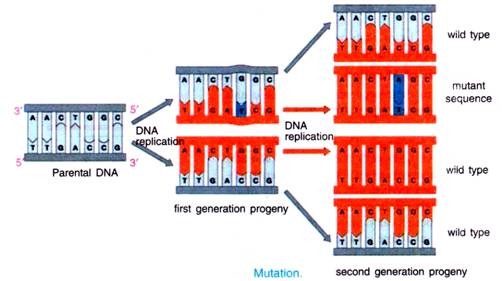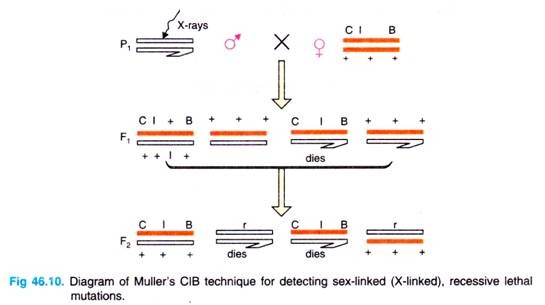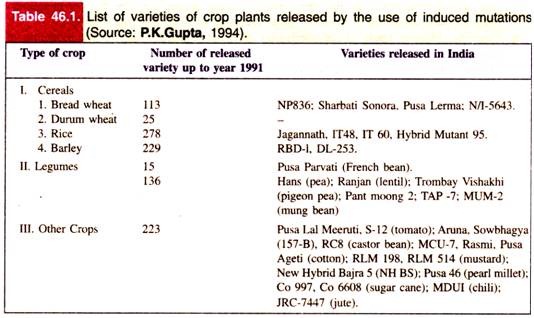Are you looking for an essay on ‘Mutation’? Find paragraphs, long and short essays on ‘Mutation’ especially written for school and college students.
Essay on Mutation
Essay Contents:
- Essay on the Introduction to Mutation
- Essay on the Historical Background of Mutation
- Essay on the Occurrence of Gene Mutation
- Essay on the Mutation Rate
- Essay on the Method of Detection of Sex-Linked Lethal Mutation
- Essay on the Practical Applications of Mutations
- Essay on the Significance of Mutations
Essay # 1. Introduction to Mutation:
A gene mutation is abrupt inheritable qualitative or quantitative change in the genetic material of an organism. Since in most organisms, genes are segments of DNA molecule, so a mutation can be regarded as a change in the DNA sequence which is reflected in the change of sequence of corresponding RNA or protein molecules. Such a change may involve only one base/base pair or more than one base pair of DNA.
Mutations occur in random manner, i.e., they are not directed according to the requirements of the organism. Most mutations occur spontaneously by the environmental effect, however, they can be induced in the laboratory either by radiations, physical factors or chemicals (called mutagens). A unicellular organism is more subjected to environmental attacks since it is at the time a somatic or germ cell.
In multicellular organisms, the germ cells are distinct cells, and are relatively protected from the environment. Mutation has a significant role to play in the origin of species or evolution.
Essay # 2. Historical Background of Mutation:
The earliest record of point mutations dates back to 1791, when Seth Wright noticed a lamb with exceptionally Mutation short legs in his flock of sheep. Visualising the economic significance of this short-legged sheep. i.e., short-legged sheep could not cross the low stone fence and damage the crop fields in the vicinity, he produced a flock of sheep, each of which having short legs by employing artificial breeding techniques.
The short-legged breed of sheep was known as Ancon breed. Later on, the trait of short legs was found to have resulted from a recessive mutation and the short-legged individuals were found to be homozygous recessive.
Hugo de Vries was the first hybridist who used the term “mutation” to describe the heritable phenotypic changes of the evening primrose, Oenothera lamarckiana. Many mutations described by de Vries in O. lamarckiana, are now known to be due to variation in chromosome number or ploidy and chromosomal aberrations (viz. gross mutations).
The first scientific study of mutation was started in 1910, when Morgan started his work on fruitfly, Drosophila melanogaster and reported white-eyed male individuals among red-eyed male individuals.
The discovery of white- eyed mutants in Drosophila was followed by an extensive search of other mutants of Drosophila by Morgan and his co-workers and other geneticists. Consequently, about 500 mutants of Drosophila have been reported by geneticists all over the world.
Later on, several cases of mutations have been reported in a variety of microorganisms (e.g., bacteriophages, bacteria (Escherichia coli), Neurospora, etc., plants (i.e., pea, snapdragon, maize, etc.) and animals, (i.e., rodents, fowls, human beings, etc.).
Essay # 3. Occurrence of Gene Mutation:
Mutations occur frequently in nature and have been reported in many organisms, e.g., Drosophila, mice and other rodents, rats, rabbits, guinea pigs and human beings. In Drosophila, mutation causes white and pink eyes, black and yellow body colours, and vestigial wings.
In rodents the mutations are responsible for black, white and brown coats. In human beings, the mutations cause variation in hair colour, eye colour, skin pigmentation and several somatic malformations. Various genetical diseases of human beings such as haemophila, colour blindness, phenylketonuria, etc., form other examples of mutation in human beings.
How does a mutation act?
Any change in sequence of nucleotides in the DNA will result in the corresponding change in the nucleotide sequence of mRNA. This may result in alignment of different tRNA molecules on mRNA (during protein synthesis).
Thus, the amino acid sequence, and, hence, the structure and properties of the enzyme formed will be changed. This defective enzyme or structural protein may adversely affect the trait controlled by the protein. In consequence, a mutant phenotype makes its expression.
Essay # 4. Mutation Rate:
The frequency with which genes mutate spontaneously is called mutation rate. Most genes are relatively stable and mutation is a rare event. The great majority of genes have mutation rate of 1 X 10-5, viz., one gamete in 100,000 to one gamete in million would contain a mutation at a given locus. Mutations occur much more frequently in certain regions of the gene than in others. The favoured regions are called hot spots.
The mutation rate is influenced by various factors which are as follows:
1. Genetic control of mutation rate:
There are ample evidences which show that mutation rate is under genetic control, viz., certain genes called mutator genes may increase the mutation rate in Drosophila, maize and E. coli. However, certain suppressor genes may decrease the rate of mutation.
In, bacteria, as well as in eukaryotes, spontaneous mutations most frequently are caused by transposons which are segments of DNA that have a tendency to jump around the genome.
2. Viral control of mutation rate:
Virus reportedly affect the mutability of host’s genes. Sprague (1963) experimented with maize suggested that virus may cause mutation. Baumiliar (1967) reported that viruses increase the mutation rate in Drosophila melanogaster. But, still we do not know how viruses increase the mutability of host genes.
3. Environmental control of mutation rate:
There are three major environmental factors that affect mutation rates, viz., temperature, certain radiations and chemicals.
Essay # 5. Method of Detection of Sex-Linked Lethal Mutation:
H J. Muller devised an easy method for detecting lethal mutations in the sex chromosomes of Drosophila. This is called a CIB method in which a special type of female fly is employed which carries a normal X chromosome and an abnormal X chromosome.
The abnormal X chromosome contains an inversion mutation C (which prevents the chromosome to do crossing over with the normal X chromosome, therefore, called crossover suppressor), a recessive lethal mutational gene, I and a dominant gene B for bar-eye.
In Muller’s CIB technique, these CIB female flies are mated with males which are previously treated with some mutagenic agent (such as X- rays) to cause mutation in some of their sperms.
The resulting zygotes are of four types and one of these, the CIB male, fail to survive because such embryos contain a recessive lethal which expresses itself when hemizygous. Thus, only one class of male (with CIB X chromosome) male remains to fertilize the F1 females.
Each heterozygous CIB female results from the fertilization of a CIB egg and an irradiated X-bearing sperm and some of these sperms will contain mutated X-chromosomes. Mated F1 heterozygous CIB females are distributed individually into culture tubes in which each lays fertile eggs and so produces a single F2 culture.
The culture produced by females bearing an induced lethal mutation contain only females; whereas female bearing irradiated X-chromosomes in which no recessive lethal has been induced yield cultures containing some wild-type males. Thus, if in a population of 1000 cultures, 990 contained some males and 10 contained only females, the induced rate of sex-linked, recessive lethal mutations would be 1 per cent.
Besides the CIB method, there are many more methods such as Muller-5 method (for the detection of sex-linked lethal mutations); attached X- method (for the detection of sex-linked visible mutations); balanced lethal systems (for the detection of autosomal mutations); and Stadler’s method and Singleton’s method (for the detection of specific loci in plants).
Essay # 6. Practical Applications of Mutations:
Mutations are generally deleterious and recessive for the organisms, therefore, majority of them are of no practical value. A. Gustafsson has estimated that less than one in 1000 mutants produced may be useful in plant breeding. In India, several useful mutations of various cereals and other crop plants have been developed (see Table 46.1).
1. Wheat:
In bread wheat, many useful mutations have been obtained and utilised in plant breeding, e.g., branched ears, lodging resistance, high protein and lysine content, amber seed colour and awned spikelet’s.
Dr. M.S. Swaminathan, one of the most distinguished and legendary figure in the field of cytogenetics and plant breeding in Indian subcontinent, had utilised amber mutation of Mexican wheat variety to develop a new variety of wheat, called Sharbati Sonora while working at Indian Agriculture Research Institute (lARI), New Delhi. According to Dr. N.E. Borlaug (Nobel Laureate), this variety of wheat paved the way for the Green Revolution in India.
2. Rice:
In rice, one of the high yielding varieties Reimei was developed through mutations isolated after gamma irradiation. Certain developed mutants of rice are found to contain increased contents of proteins and lysine. In certain other mutant rice, the duration of crop was reduced by as many as 60 days.
3. Barley:
In barley, mutations called erectoides and eceriferum have been induced. These mutants had high yields including several useful characters.
Essay # 7. Significance of Mutation:
The vast majority of mutations are deleterious to the organism and are kept at low frequency in the population by the action of natural selection. Mutant types are generally unable to compete equally with wild-type individuals. Even under optimal environmental conditions many mutants appear less frequently than expected.



